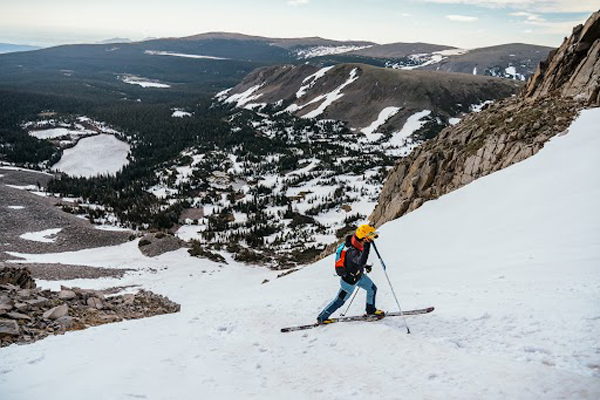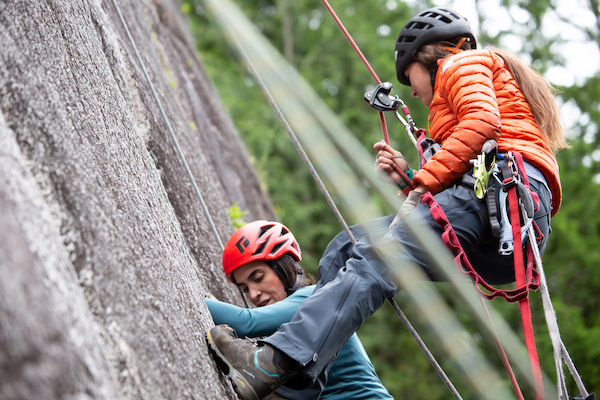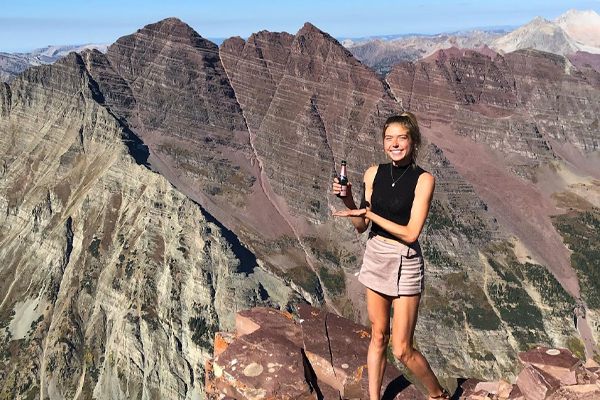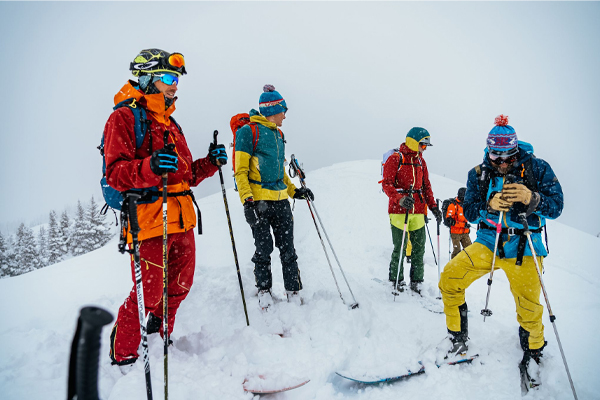Empath Interview - Keenan Takahashi

La Sportiva athlete Keenan Takahashi sits down with videographer Caroline Treadway to talk about Empath and his process of sending the route...
- - -
Caroline: Can you give me a rundown on the climb and what it was like climbing with Paige?
Keenan: For sure. The route kind of boils down to four-ish sections. The breakdown is strange because on paper it sounds chill, 5.13 into v8 into v10 into v8, but the rests are pretty bad. You’re just slowly getting powered down and can’t recover fully.
I broke the crux hold, a crimp, on my second or third day this season, and couldn’t figure out which way to do it after that. Paige said I needed to decide on a method for the crux, which was super helpful. I kept doubting my initial method from the ground and found all these other more powerful ways. I fell at that move something like eight days from the ground, trying a lot of different ways, which was a real mental battle. That move is kind of the gateway to sending because the next moves are a little more secure and the hands and feet are better. When I finally committed to my method, it started to unravel. Paige’s advice to choose a method and stick to it was a huge breakthrough.
The first part is probably 13- then you climb a v8 to the poor rest. Then the next boulder is v10ish and then you probably have a v8 final boulder. This final boulder is chill in isolation, then from the ground, you’ve just been squeezing or lie-backing, and the whole end boulder is power lie-backing, both rests are lie-backing. Having to do that same style of climbing makes the end hard from the ground. You do the final boulder being at 60% or 70% when it’s not that easy in general.
I kind of just had to go into a different mindset. The key for me was realizing that instead of being efficient, I needed to go all out at the end and pretend I was bouldering. On the go, I was like, “I’m trying fucking hard right here and I just want to high point.” I got super aggressive and started yelling, which made me super adrenalized and I felt surprisingly good actually. From the final clip, it’s probably only v3 or v4 but it’s still kind of on you, and you could mess it up if you’re death pumped.
Caroline: Can you talk about Paige’s approach and what you like about it? I feel like there’s mutual respect between the two of you. How does her style compare to yours, what would happen if she tried to do it your way?
Keenan: Paige and I have a very different approach. I think we’re almost polar opposite; she’s super in tune with what she does but doesn’t necessarily articulate it after, whereas I can articulate handhold and foothold sequences pretty well but the in-between body movements are not as clear to me. She climbs via intuition and I climb via sequences. There’s good and bad to both styles. It’s really cool to see someone climb with a different approach and style and still climb super well. I see climbing in a broader view and there are so many ways to approach a project and ways that work. It’s cool because a lot of times I get hyper-obsessive and Paige is really chill about her projects.
She doesn’t seem phased when she’s not having a good day or the conditions aren’t that good. She just tries hard. In my eyes, it’s the best attitude you can have toward climbing and life in general. It’s admirable. It’s been sick to climb with her and try to emulate that style.
I don’t know if it necessarily comes easily to her because we’re super opposite in the way that she’s fairly analytical about the rest of her life apart from climbing and is maybe more concerned with other aspects of her life whereas a lot of times I’m pretty chill about other aspects of my life and with climbing, I’m hyper-focused and get stressed when things are going badly and get frustrated. Maybe that’s why we can empathize so well; we have the same tendencies in different facets of life.
Paige is kind of a zen master about leaving the project at the cliff. When she’s hiking out, she’s not thinking about it anymore. It is really healthy because I’m thinking about how I should have done stuff differently, and she’s like, “what are we making for dinner that’s going to be super tasty... or, even better, dessert?” That’s really refreshing and helps me see climbing in a different way, which for me is the raddest part about projecting with someone else.
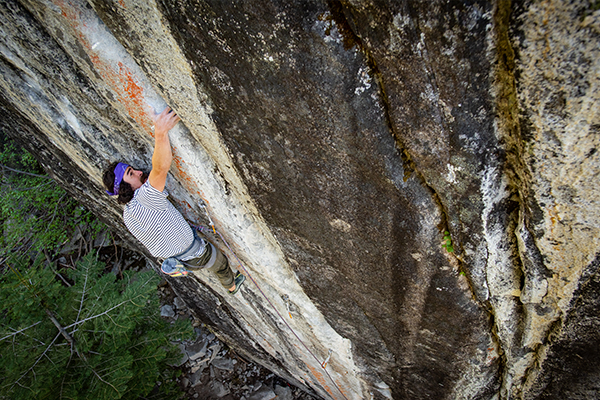
Caroline: Do you see other boulderers with that attitude?
Keenan: Daniel (Woods) is like that. He is the closest to zen master outside of climbing. When shit goes wrong he’s like, “It is what it is.” Outside from climbing Daniel is fully DGAF. In Vegas, he’s sleeping in a tent trying to climb v17. He’s just chilling doing his thing. I think I wish I could be more like that. I would hope it’s something you can train, but I'm not sure I can get to that level where it’s fully like I've left. I could do better and am psyched to try to do that. It seems nice in general to not be stressing about sequences for the next six hours. My way creates a lot of pressure and I don’t necessarily like that pressure to perform or the expectations that go along with that.
Caroline: Do you usually have high expectations of yourself?
Keenan: I don’t necessarily have high expectations, but I do have some expectations of a day. It’s not like, “I need to send this day”, just that I need to do better in some aspect. I try to have mini-goals like doing a sequence better or finding better beta. If I accomplish that, it’s a good day. That helps in the long run. It’s tricky because as soon as you get into comparisons that creates expectations, and I screw myself and feel shitty about myself as a climber.
Caroline: Did Paige do it in a similar way?
Keenan: It was sick climbing on it with Paige because she and I have really different approaches to projecting in general. Normally I’m hyper obsessive with microbeta and she’s a much more intuitive climber and kind of figures out a sequence. I ask what she did and she’s like, “I don’t really know,” but gets on the wall and does the exact same thing; her body and mind are interlinked where she knows how to do it but it’s just intuitive. I feel like I am analytical to a fault where a lot of times I’m thinking about a section of moves. For example, at the end crux, you build this foot and there’s always this one sensation of how to turn the knee. I would always do it correctly in isolation and then when I was trying to describe how I did it I couldn’t articulate what I was doing that made the move feel okay. It took me a while to figure out that I’m blocking the knee so I have to lean out and turn the knee under so I can get the space to lift up. Paige is super good at these little body English things, and understands and can replicate them really well. I know I do something weird with my knee, but if I overthink it I would screw myself.
One thing that’s good about her approach is that she’s super focused at the cliff even though she keeps it light and fun, but when she leaves the cliff she leaves the route behind. I go home and am obsessing over particular moves and am staying up at night. All my beta breakthroughs are right before I go to bed because I’m thinking about the route so much. Then I’ll have a lightbulb moment like, “if I shift a hand I can pull better.”
There’s something good about obsessing because I often find methods that work well for me but it’s also mentally exhausting when I don’t leave the route behind. It’s still at the front of my mind. But Paige can take space from the route which is really healthy and maintains it being fun and it being enjoyable, whereas I can screw myself over by being too obsessive. That’s definitely the case with this one. I’ve never been so emotionally invested with a route. That’s hard for me at times and confusing because it’s new.
Sport climbing, in general, is not something I've done that much so I don’t have past experiences where I know, “this works for me and this doesn’t.” Paige brings two decades worth of knowledge of efficiency, breathing, and projecting sport routes in general. It’s different from my experience bouldering and I had a lot more regression on the route than I’m used to, which is hard to deal with. I have a note on my phone notes with “Paige-isms” like not judging days by my warm-up or starting my breathing before I get on the wall to set the tone for the pace of the breath. Paige told me about this which helped me a ton. If something is going wrong on the route I’m not focusing on something being wrong but instead on my breath.
With bouldering, you don’t climb as much in one day, whereas on this route I’m climbing three or four times up it, which is a dozen boulders v8 to v10 every day. The moves I’m trying when projecting a boulder are harder but I’m only doing two or a few at a time. To be doing 20 or 30 moves at a time versus two at a time I need to eat way more food than what I’m used to. The first week I was not eating enough food and Paige told me I needed to eat more. I started packing some big lunches which helped prevent me from feeling shaky on the wall.
I learned a lot of lessons from Paige of full-process things, from warmup to projecting and general tactics. I also learned some broader lessons, like how she doesn’t stress as much about her projects; she doesn’t get super frustrated or angry. That’s something I strive for... which I didn’t accomplish with this route, but it’s something I’m working on. It’s cool to have her show me that it works and is a way to approach things in a much more mentally liberated way.

Caroline: You like to verbalize beta; what is it about it that helps you send? Paige doesn’t need to verbalize beta, is there something about verbalizing that makes you feel like you can memorize every move and you’re more likely to send it?
Keenan: I just need to be able to run through the entire sequence in my head as fast I can climb it. If I can’t run through the sequence in my mind, then on the wall I'll be pausing and inefficient. Being able to run through the sequence as quickly as possible without making an error is something I can do when I’m not at the cliff, so it’s a form of training that’s passive and doesn’t mess with my recovery. It’s also something that gives me confidence and I know exactly what to do; it’s kind of a way to enter that mode of climbing it when I verbalize it. I go into that mindset like, “I need to breathe here and get a mini shake here and clip quickly here if I can”, and do a bunch of little things. It helps me compartmentalize it all and reinforces the pace at which I can do it.
I think the first time I ran through my sequence it was day 4 and I had 90% of my beta down. I was driving back and I was trying to run it through in my head - it took me a really long time so I knew I needed to be faster because my processing time on the wall would be too slow. It has to be a fluid thing so my body can go as fast as possible because I like to climb fast in general. I like to be as efficient as possible with my climbing.
I know that when I arrive at certain sections if I’m physically exhausted there’s a mental toll that goes along with that. I don’t want to be second-guessing my beta and wondering if I should be going left hand or right hand or worst of all, forgetting what the sequence is. I think that the rehearsal that I do is just to get me to a point where I’m confident when I arrive there I just need to focus on execution. And I just know what I’m supposed to be doing and try to do it. Even if I’m tired and it’s hard to focus, with route climbing you’re in small mental battles all the time.
Caroline: It’s interesting because if Paige tried to do that it might actually mess her up.
Keenan: It’s fascinating how we have such a different approach but it works for both of us in a very different way. It’s like traveling: you see a different place or way of living and realize there’s a lot that you can utilize in your own life to make your own life better. I love climbing with people with other skill sets and Paige’s intuition on the wall and energy and psych that she brings to the crag is something I want to have and bring anywhere I go climbing.
Caroline: She’s really not hung up.
Keenan: She’s so chill about projecting and I’m just freaking out. I love how chill she is because that’s the goal. She just tries hard and is like, “It is what it is”, and I’m like, “I didn’t highpoint, this sucks.” She has some logical explanation as to why I didn’t high point, and I feel better but... I still didn’t high point. Generally, I have a pretty good attitude about not sending as long as I see progress. With this route, I think it was harder to see that progress when it wasn’t a high point.
Caroline: Can you talk to me a bit about Pablo (Hammack)?
Keenan: Pablo is a super young crusher that I started climbing with some time last fall or winter. I had first heard of him because he did this project I was trying in Black Mountain. I was like, “Who is this kid?” He's 20 now. He’s a really low-key boulderer from California who has been on a tear. He sent Sleepwalker (V16) and his hardest route is only 5.13+ and now he’s pretty much sending Empath. He’s super chill, and brings positive energy to the cliff, and is rather mature for a 20-year-old. He’s on a good track and it’s been rad to climb with him. He’s super strong so it’s cool to see him make links. I’m psyched to have been climbing with him on the route the whole time.
I think for us boulderers it’s a sick route: not super long or powerful, good granite and fun climbing. He’s had some big ups and downs; we’ve had a similar process of dealing with a lot of regression that neither of us is used to. He’s had some big breakthroughs with trying hard - he told me early on that it doesn’t feel hard when he does things. I feel like everything I do that’s been limited for me has been super hard on the go and what pushed me to send was getting into that try-hard effort. He’s had some breakthrough moments on the route where he tried really hard and did significantly better.
It’s been rad for him to see that aspect of climbing, it doesn’t always have to feel like you’re floating. There’s a lot of visible improvement from trying harder with sport climbing, you get into this fight, which I love the most about sport climbing. It’s been rad to see him embrace that. You go into fight mode and it’s cool to see him progressing. My favorite part of sport climbing is engaging battle mode. It’s cool to see some climbing progression, not just on the route but in climbing in general. There was a freak weather window, and he went back to Yosemite and established the hardest boulder in the Valley two or three days after having his try hard breakthrough. I was texting him telling him to remember to try hard. It’s cool to see growth and that we’re all improving as climbers.
Caroline: Do you think it’s the hardest thing you’ve done?
Keenan: It’s complicated. If it was the hardest thing I had done, then I wouldn’t have been able to do it that day, because I was so tired... but before I did it, I thought it would definitely be the hardest thing I’ve done. It’s for sure the hardest sport route I’ve done, but it’s weird to say it’s the hardest piece of rock I’ve climbed. It’s not clear to me but it’s definitely up there. It’s mentally been in the top three hardest or maybe the hardest. I definitely have not had that much of a mental battle with anything else before. I’m psyched to have broken through mentally!

